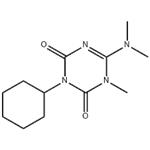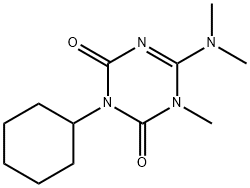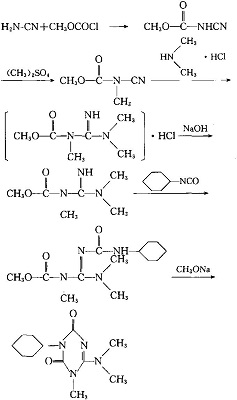- Hexazinone
-

- $6.00 / 1KG
-
2024-01-24
- CAS:51235-04-2
- Min. Order: 1KG
- Purity: 99%
- Supply Ability: g-kg-tons, free sample is available
- Hexazinone
-

- $1.00 / 1g
-
2020-01-10
- CAS:51235-04-2
- Min. Order: 1g
- Purity: 99.0%
- Supply Ability: 100kg
|
| Product Name: | Hexazinone | | Synonyms: | 1,3,5-Triazine-2,4(1H,3H)-dione, 3-cyclohexyl-6-(dimethylamino)-1-methyl-;hexazinone (bsi,iso,ansi,wssa);hexazinone solution;Hexazinone(Velpar);3-cyclohexyl-6-dimethylamino-1-methyl-1,2,3,4-tetrahydro-1,3,5-triazine-2,4-dione hexazinone;Hexazinone-d6;Hexazinone 0.1;Velpar 1g [51235-04-2] | | CAS: | 51235-04-2 | | MF: | C12H20N4O2 | | MW: | 252.31 | | EINECS: | 257-074-4 | | Product Categories: | Pesticides&Metabolites;Triazinone structure;Alphabetic;Analytical Standards;V;Alpha sort;H;HA -HTPesticides&Metabolites;Herbicides;H-MAlphabetic;HERBICIDE | | Mol File: | 51235-04-2.mol |  |
| | Hexazinone Chemical Properties |
| | Hexazinone Usage And Synthesis |
| Chemical Properties | The pure product is white crystalline solid. m.p.115~117℃. Vapour pressure is 2.7×10-3Pa (25℃)、8.5×10-3Pa (86℃). Relative density is 1.25. The solubility at 25 ℃: 3880g/kg in chloroform, 2650g/kg in methanol, 836g/kg in dimethylformamide,790g/kg in acetone, 940g/kg in benzene, 386g/kg in toluene, 3g/kg in hexane and 33g/kg in water. In the water solution with pH value of 5~9, it is stable at normal temperature and will be decomposed by microbes in the soil.
| | Uses | Post bud contact killing herbicide and the inhibitor of photosynthesis in plants. Its weed killing spectrum and killing shrub spectrum are wide, and its toxicity is strong and effective. It is used for tending young forests of evergreen coniferous forests, such as Pinus koraiensis, Pinus sylvestris, Picea spruce, Pinus massoniana and so on. Before the afforestation, it is applied to weeding and extinguishing irrigation, maintaining and opening forest fire prevention and forest soil improvement etc...It can also be used for weeding and irrigation on both sides of the oil depot, airport and road. It can prevent green bristlegrass, filipendula palmate, angelica dahurica,sedge, herba elsholtziae, reed, deyeuxia angustifolia, fern, clematis, veronica spuria, cephalanoplos segetum, wild oats, quinoa, millet, etc.. The woody plants it can can control include yellow lonicera japonica, pearl, hazel wood, spiraea salicifolia, acanthopanax senticosus, acanthopanax, winged elm, aspen, birch, quercus mongolica, linden, oak, linden, ashtree, phellodendron amurense rupr, juglans mandshurica etc.. It can control annual weed and biennial weed. A dose of 2~5kg/hm2 control weeds for a short term. Most perennial weeds can be prevented by the dose of 6~12kg/hm2. Nonionic surfactants can be added to this product.
| | Mechanism of action | It mainly inhibits the photosynthesis of plants and causes the disordered generation of plants and causes death. Both plant root and leaf surface can absorb the cyclohexanone, which is transported mainly through the xylem. It has great mobility in the soil and can be decomposed by soil microbes after entering the soil. It has no harm to the root of the pine tree. 7 days after the weeds have been treated, the leaves will have necrosis until the whole leaf has withered. The whole process including the upper part above ground (about 2 weeks) and the rotting of the root lasts for 1 month. It will last for 1 month from the appearance of necrosison the new leaves to rotting roots of the shrubs lasts for about 2 months. The first defoliation of non - objective arbor takes place 20~30 days after the injury. In the future, the new born leaves will be molted again, repeating 3~5 times in a row. From the spot to the formation of shrub leaf rot lasted for about 2 months. The upper part of the ground dies in 60~120 days. The roots rot in the fall of second.
| | Toxicity | The drug is of toxicity when acute oral LD50 is 1690mg/kg in rats, acute percutaneous is LD50>5278mg/kg in rabbits, acute transdermal is LD50>2000mg/kg in rats. It has a stimulating effect on the eyes of rabbits. The accumulative coefficient K value is >5, which belongs to the mild accumulative pesticide.There is no teratogenic, carcinogenic and mutagenic effects on animals within the range of experiments. No abnormality is found in the three generation reproduction test and neurotoxicity test. The non-cation dose for two years of feeding test: 200mg/kg for rats,LC50388mg/L for rainbow trout, LD50>5000mg/kg for quail, LD50>10000mg/kg for wild duck and, LC5060μg for per bee.
| | Preparation method |  | | Description | Hexazinone is a white crystalline solid that ispractically odorless. Molecular weight = 252.36; Boilingpoint = decomposes; FreezingMelting point= 115-117℃; .Vapor pressure= 3.0X 10厂' mmHg. Soluble in water. | | Uses | Hexazinone is a triazine compound used as a preemergence or postemergence herbicide to control many annual grasses and broad-leaved weeds in noncropped land and certain crops such as alfalfa, blueberries, coffee, pecans and sugarcane | | Uses | Herbicide. | | Production Methods | Hexazinone is a postemergence contact herbicide effective
against many annual and biennial weeds and, except for
Johnson grass, most perennial weeds. Human contact is
likely at the use stage, and dermal contact and inhalation
are of most concern. | | Definition | ChEBI: Hexazinone is a member of 1,3,5-triazines. | | General Description | White crystalline solid. Corrosive eye irritant. Used as an herbicide. | | Air & Water Reactions | Water soluble. Rapidly decomposed in solution by strong acids and bases. | | Reactivity Profile | A triazine. | | Potential Exposure | Those involved in the manufacture,formulation, and application of this contact and residualherbicide. It is a broad spectrum herbicide used in industrialand government right-of-way weed control for pipelines,drainage ditches, etc. | | First aid | If this chemical gets into the eyes, remove anycontact lenses at once and irrigate immediately for at least15 min, occasionally lifting upper and lower lids. Seek med-ical attention immediately. If this chemical contacts theskin, remove contaminated clothing and wash immediatelywith soap and water. Seek medical attention immediately. Ifthis chemical has been inhaled, remove from exposure,begin rescuebreathing (using universal precautions, includ-ing resuscitation mask) if breathing has stopped and CPR ifheart action has stopped. Transfer promptly to a medicalfacility. When this chemical has been swallowed, get medi-cal attention. Give large quantities of water and inducevomiting. Do not make an unconscious person vomit. | | Carcinogenicity | No carcinogenicity was detected
among pups of rats fed up to 5000 ppm for 2 years.
Similarly, no increase in tumors was produced by feeding up
to 10,000 ppm hexazinone to mice. | | Environmental Fate | Soil/Plant. Biodegrades in soil and natural waters releasing carbon dioxide. The reported half-life in soil is 1 to 6 months (Hartley and Kidd, 1987). Rhodes (1980a) found that the persistence of hexazinone varied from 4 weeks in a Delaware sandy loam to 24 weeks in a Mississippi silt loam.
Hexazinone is subject to microbial degradation (Rhodes, 1980a; Feng, 1987). Metabolites identified in soils, alfalfa and/or sugarcane include 3-(4-hydroxycyclohexyl)-6(dimethylamino)-1-methyl-1,3,5-triazine-2,4(1H,3H)-dione, 3-cyclohexyl-6-(methylamino)-1
Feng (1987) monitored the persistence and degradation of hexazinone in a silt loam soil 104 days after treatment of the herbicide. After 104 days, 66% of the hexazinone degraded via hydroxylation to form the major metabolite 3-(4-hydroxycyclohexyl)-6(dime
No traces of hexazinone or its metabolites were detected on treated blueberries (Jenson and Kimball, 1985).
Photolytic. Photodegradation products identified in aqueous hexazinone solutions following exposure to UV light (λ = 300–400 nm) were 3-(4-hydroxycyclohexyl)-6-(dimethylamino)-1-methyl-1,3,5-triazine-2,4(1H,3H)-dione, 3-cyclohexyl-6-(methylamino) | | Metabolic pathway | In clay and sand soils, hexazinone is metabolized by
hydroxylation at the 4-position of the cyclohexane ring
and mono-N-demethylation to give [3-(4-
hydroxycyclohexyl)-6-(dimethylamino)-1-methyl-1,3,5-
triazine-2,4-(1H,3H )-dione], and [3-cyclohexyl-6-
(methylamino)-1-methyl-1,3,5-triazine-2,4-(1H,3H )-
dione, respectively. N-Demethylated metabolite is
found in a comparatively higher percentage than the
hydroxylated metabolite in both clay and sand soils. | | storage | Color Code- -Blue: Health Hazard/Poison: Storein a secure poison location. Prior to working with thischemical you should be trained on its proper handling andstorage. Store in tightly closed containers in a cool, well-venti lated area above 32℃. | | Shipping | Hexazinone is classified as Triazine pesticides,solid, toxic n.o.s. This compound requires a shipping labelof“POISONOUS/TOXIC MATERIALS.”It falls in HazardClass 6.1 and Packing Group II. |
| | Hexazinone Preparation Products And Raw materials |
|